Contents
Market Overview
Macro Update
Markets this week navigated a challenging mix of short-term disruptions and longer-term structural concerns, shaped most notably by the ongoing U.S. federal government shutdown and the reemergence of U.S.-China trade tensions. Now in its third week, the shutdown has delayed the release of critical economic data – including CPI, PPI, and retail sales – compelling investors to lean more heavily on private-sector indicators and central bank signaling.
Against this backdrop, the latest Beige Book release underscored the complexity of the Fed’s policy outlook. While several districts reported softer labor conditions, which aligned with Chair Jerome Powell’s recent comments, rising input costs and evidence of both supply- and demand-side pressures suggest a more nuanced inflation and employment picture. The path to further rate cuts is not yet clear, and the Fed’s heavy reliance on backward-looking data risks underestimating the crosscurrents in play.
Available private-sector data this week painted a slightly weaker economic picture. The NFIB Small Business Optimism Index fell to 98.8 in September, while the Philadelphia Fed’s manufacturing index unexpectedly dropped to -12.8. Mortgage applications declined, and the NY Fed’s services index came in at -23.6. Although the Empire Manufacturing survey improved modestly, the underlying components continue to reflect softness in demand and employment.
U.S.-China trade tensions have returned to the forefront ahead of the scheduled October 29th meeting between Presidents Donald Trump and Xi Jinping. The U.S. administration’s consideration of a 100% tariff on Chinese imports – should Beijing proceed with rare earth export restrictions – highlights the broader weaponization of trade and industrial policy as macroeconomic tools.
Markets were relatively resilient through most of the week; however, news late Thursday that two U.S. regional banks flagged potential loan fraud reignited concerns about credit quality and financial sector vulnerabilities that put pressure on stocks. Nonetheless, the S&P 500 is ending the week up 1.2%. Treasury yields, which had been stable, headed lower as risk sentiment deteriorated Thursday and the 10-year U.S. Treasury dipped below 4%. The dollar weakened modestly but oil prices fell more substantially with WTI and Brent ending the week at $57 and $61, respectively, on weaker demand expectations. Gold extended its rally, rising to nearly $4,300 per ounce, reflecting ongoing safe-haven demand amid macro and geopolitical uncertainties.
International developments added additional layers to the outlook. UK labor market data continued to soften, with cumulative job losses exceeding 270,000 since October and the unemployment rate rising to 4.8%. Slower wage growth and higher corporate taxes have raised expectations for a Bank of England rate cut as early as November. In the euro area, trade and services data were disappointing, reinforcing questions about the region’s recovery momentum.
Emerging markets were in focus during the IMF and World Bank meetings where investor sentiment remained broadly supportive of the asset class, notwithstanding still elevated uncertainty. High real-yield currencies were still favored despite a recently stable dollar relative to G-10 currencies. Brazil’s below-consensus growth data strengthened the case for rate cuts by early next year, while ongoing fiscal reforms in Brazil were topical. Meanwhile, policymakers from Chile, Colombia, Ghana, and Türkiye emphasized disinflation and fiscal discipline. Argentina’s $20 billion swap agreement with the U.S., reported discussion of fresh U.S. bank financing, as well as the upcoming mid-term vote on October 26th, were other key points of discussion among investors.
Meanwhile, President Javier Milei’s meeting with President Trump underscored the importance of robust policymaking and political strategy in the aftermath of the election. In Venezuela, reports surfaced of U.S. authorization for covert action against President Nicolás Maduro, while opposition leader Corina Machado, who was recently awarded the Nobel Peace Prize, has seen her domestic and international profile rise. Protests in Madagascar turned deadly amid worsening public services, prompting a government reshuffle. In Morocco, tensions eased slightly following healthcare concessions, though mass arrests continued. Moldova advanced EU accession talks after pro-European parties consolidated power, while the EU approved €500 million for a drone surveillance system to counter ongoing Russian airspace violations.
EM Credit Update
Emerging Markets (EM) fixed income delivered another week of solid gains. EM hard-currency sovereign bonds returned 0.72%, led by high-yield names at +0.91% vs. +0.53% for investment grade. At the index level, spreads tightened by 3 bps, driven by an 8 bps compression in high-yield debt.
Performance was broadly positive across regions. Lebanon led gains, buoyed by a wave of positive sentiment following the Israeli-Hamas ceasefire agreement. Venezuela also outperformed, as market participants increasingly priced in regime change risks amid rising speculation of potential U.S. military involvement. In contrast, Argentina lagged, with investor sentiment deteriorating in the absence of clarity around external support ahead of the October 26th deadline.
Local currency debt also performed well, returning 0.84%, supported by a weaker U.S. dollar and declining Treasury yields as U.S. employment data softens and early signs of credit stress emerge. Romania, Peru, and Hungary outperformed, driven by favorable rate dynamics and better domestic sentiment. Brazil and the Dominican Republic underperformed – Brazil on the back of stalled fiscal reform efforts, and the DR due to continued foreign exchange weakness following last month’s surprise rate cut.
EM corporate debt posted a more modest +0.24% gain, with investment grade outperforming high yield (+0.27% vs. +0.20%). Spreads widened by 7 bps overall, reflecting broad but shallow repricing. Regionally, Latin America led returns, with Brazilian corporates rebounding from last week’s headline-driven volatility. Eastern Europe was the main underperformer as Turkish corporates came under renewed pressure due to politically driven investigations into company shareholders, weighing on sentiment. Duration remained in favor, with the 10+ year bucket delivering the strongest returns.
Primary market activity slowed meaningfully, with just five new hard-currency deals priced during the week, all from investment-grade issuers. Amid broader credit caution, Asia accounted for roughly 60% of the week’s new issuance.
The Week Ahead
Markets await the delayed September CPI report, a key input for assessing the likelihood of Fed rate cuts heading into 2026. Additional signals on the economy will come from PMI and the University of Michigan consumer sentiment surveys, as well as from earnings from major US companies, including Netflix, GM, Ford, and Tesla. Meanwhile, the Fed will hold a conference on payment system innovation in relation to cryptocurrencies and AI.
In Europe, eurozone consumer confidence and PMI will be released, while ECB President Christine Lagarde, BOE Governor Andrew Bailey, and other ECB Governing Council members are scheduled to speak at conferences throughout the week.
In EM, China will hold its Fourth Plenum to discuss its five-year economic plan, while third-quarter GDP, retail sales, industrial production, and property investment data releases are anticipated to show softening. Monetary policy decisions from Hungary, Türkiye, Indonesia, South Korea, and Ukraine are also on deck. Markets largely anticipate rate cuts in Türkiye and Indonesia.
Bolivia will hold its run-off presidential vote, in which center-left candidate Rodrigo Paz will face right-leaning contender Jorge “Tuto” Quiroga, marking the end of two decades of MAS rule. While polls favor Mr. Quiroga, many analysts are expecting a Paz victory. From a market perspective, attention will turn to whether the new administration can navigate much-needed macroeconomic adjustments to address large fiscal and external imbalances.
Fixed Income
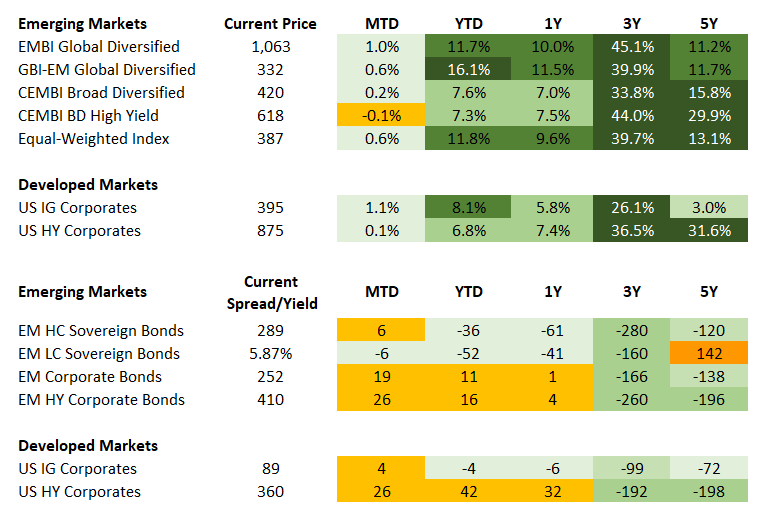
Equities
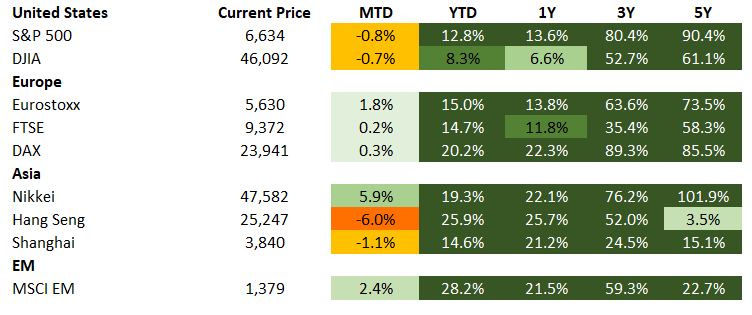
Commodities

Source for data tables: Bloomberg, JPMorgan, Gramercy. EM Fixed Income is represented by the following JPMorgan Indicies: EMBI Global, GBI-EM Global Diversified, CEMBI Broad Diversified and CEMBI Broad High Yield. DM Fixed Income is represented by the JPMorgan JULI Total Return Index and Domestic High Yield Index. Fixed Income, Equity and Commodity data is as of Oct. 17, 2025 (mid-day).
Highlights
Brazilian Corporate Credit Market Affected by Wave of Volatility
Event: Brazilian corporate credit came under pressure late last week, as a market rumor involving Raízen, an investment-grade company and the country’s largest fuel distributor, added to already fragile sentiment. Investor jitters had been building following earlier idiosyncratic headlines from Ambipar, which filed for U.S. bankruptcy protection, and Braskem, which hired advisors to evaluate strategic options. The combination of events triggered a broad, headline-driven sell-off across the sector, resulting in temporary contagion even among fundamentally sound names. Risk tone improved after Raízen and its shareholders, Cosan and Shell, released a statement highlighting the company’s ample liquidity and continued work to secure a capital injection that would reduce leverage.
Gramercy Comment: While these developments are idiosyncratic and not indicative of broader systemic stress in Brazilian credit, they underscore the importance of active management and rigorous bottom-up research, particularly in a low-spread environment. In this context, prioritizing issuers with strong liquidity, limited near-term refinancing needs, solid governance, and resilient business models is essential. Conversely, companies with elevated leverage, tighter debt maturity profiles, or significant working capital demands are likely to remain under closer investor scrutiny.
Emerging Markets Technicals
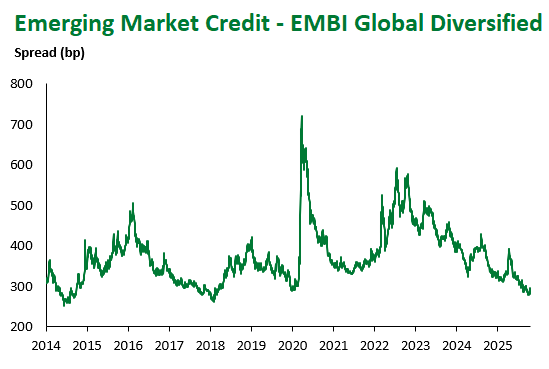
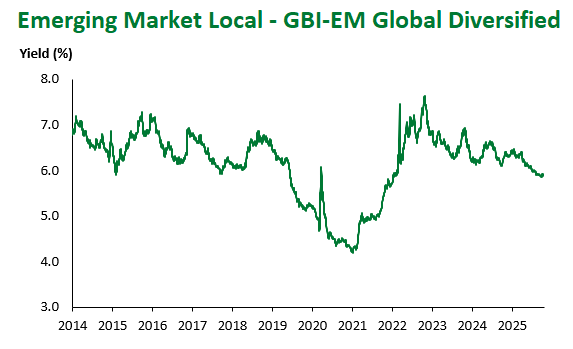
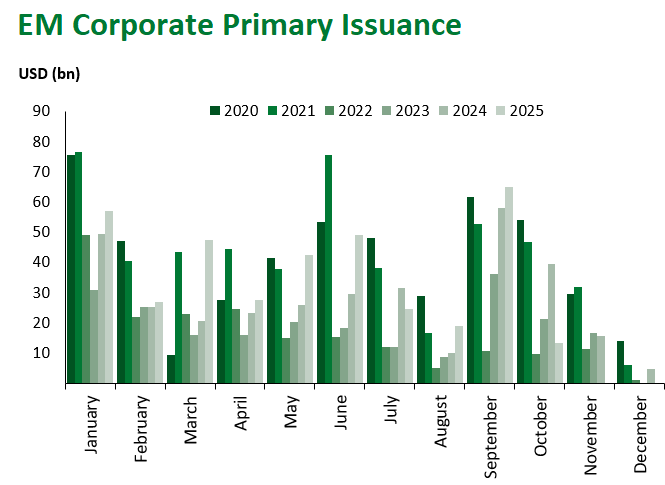

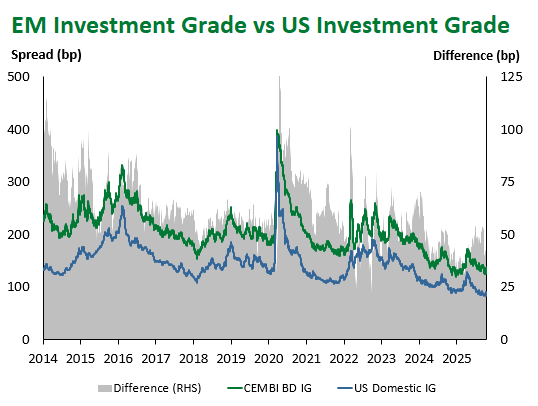
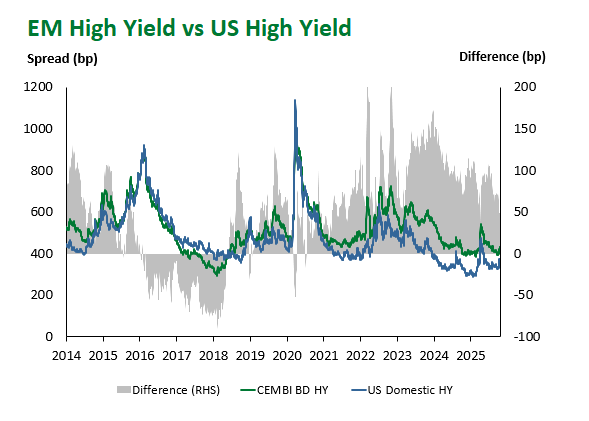
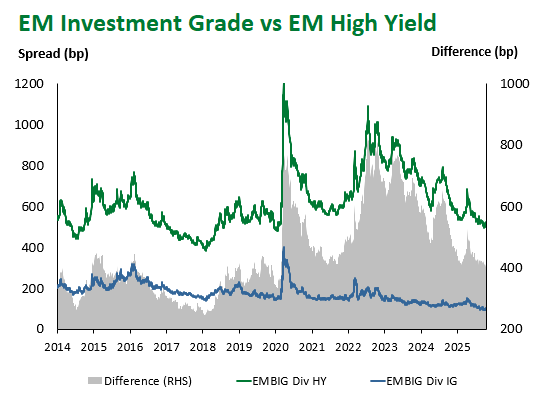
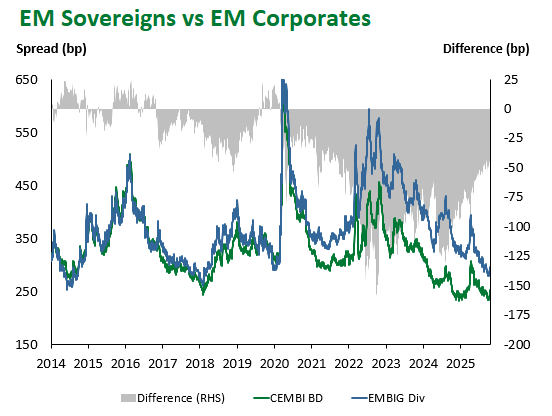
Emerging Markets Flows
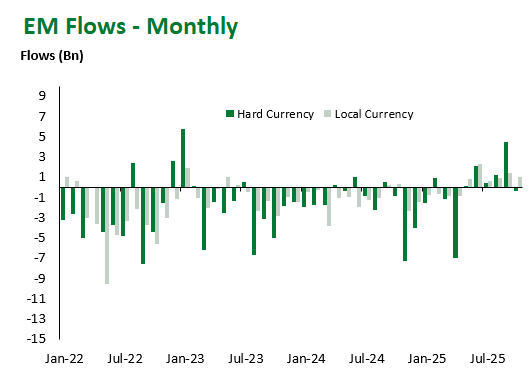
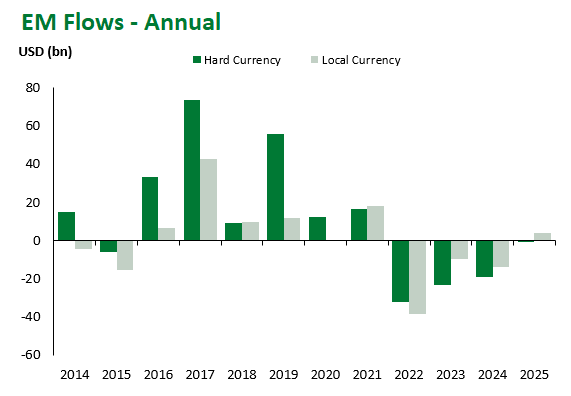
Source for graphs: Bloomberg, JPMorgan, Gramercy. As of Oct. 17, 2025.
For questions, please contact:
Kathryn Exum, CFA ESG, Director, Co-Head of Sovereign Research, [email protected]
Petar Atanasov, Director, Co-Head of Sovereign Research, [email protected]
This document is for informational purposes only. The information presented is not intended to be relied upon as a forecast, research or investment advice, and is not a recommendation, offer or solicitation to buy or sell any securities or to adopt any investment strategy. Gramercy may have current investment positions in the securities or sovereigns mentioned above. The information and opinions contained in this paper are as of the date of initial publication, derived from proprietary and nonproprietary sources deemed by Gramercy to be reliable, are not necessarily all-inclusive and are not guaranteed as to accuracy. This paper may contain “forward-looking” information that is not purely historical in nature. Such information may include, among other things, projections and forecasts. There is no guarantee that any forecasts made will come to pass. Reliance upon information in this paper is at the sole discretion of the reader. You should not rely on this presentation as the basis upon which to make an investment decision. Investment involves risk. There can be no assurance that investment objectives will be achieved. Investors must be prepared to bear the risk of a total loss of their investment. These risks are often heightened for investments in emerging/developing markets or smaller capital markets. International investing involves risks, including risks related to foreign currency, limited liquidity, less government regulation, and the possibility of substantial volatility due to adverse political, economic or other developments. References to any indices are for informational and general comparative purposes only. The performance data of various indices mentioned in this update are updated and released on a periodic basis before finalization. The performance data of various indices presented herein was current as of the date of the presentation. Please refer to data returns of the separate indices if you desire additional or updated information. Indices are unmanaged, and their performance results do not reflect the impact of fees, expenses, or taxes that may be incurred through an investment with Gramercy. Returns for indices assume dividend reinvestment. An investment cannot be made directly in an index. Accordingly, comparing results shown to those of such indices may be of limited use. The information provided herein is neither tax nor legal advice. Investors should speak to their tax professional for specific information regarding their tax situation.
